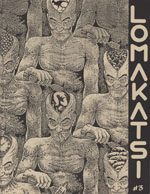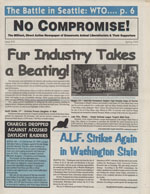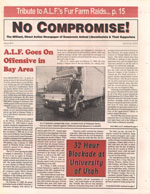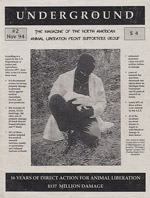The Archives
-
Periodicals
Frontline News – The Complete Set!
09.19.20 | PermalinkALF Canada Frontline News #1-4 (1985-1987 Toronto, ON. Canada)
Frontline News was the predecessor to Combat and Underground as well as the popular 1990s website animal-liberation.net. The early issues were typed and mimeographed newsletters, while issue 3 and 4 were more professional and moved to newsprint. It has taken us 9 years to find issue #2. Special thanks to Matthew Jones for tracking it down and sending the scans.
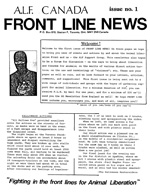
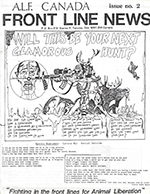
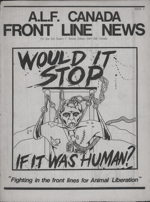

…
-
No Compromise, Periodicals
No Compromise #20-22
11.15.12 | PermalinkNo Compromise #20-22 (2003. Santa Cruz / San Francisco, CA)
No Comp scored another great year in 2003, this time by going deeper into practical instructions for campaigning, and also by examining the smaller stories in greater detail. While the high profile victories of anti-HLS activists were given their due, inspirational figures who had passed on were also given touching coverage. Issue #20 features articles on early Band of Mercy and Animal Liberation Front founder Sue Smith, and Sweden’s animal lib die-hard, Ake Soderlund. Similar examinations of our past, and the courageous figures whose shoulders we stand upon, pepper the 2003 issues. Of particular note is the article on Henry Hutto in issue #21.
2003 was also the year that Rod Coronado finally got off of probation and was allowed to participate in the movement again. His writings for No Compromise were as subversive and inspiring as ever, and it is easy to see why the government considered him such a threat.
As the year progressed No Comp moved to a magazine format and tightened their graphic design skills in response to Jake Conroy’s work on the SHAC USA newsletter. These glossy issues were excellent contributions to the movement, and it is a shame that in only a few more years NC would cease to exist altogether. These information (and inspiration!) packed issues are worth reading again to inform and encourage our current actions.


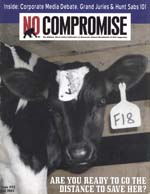
-
No Compromise, Periodicals
No Compromise #18-19
10.23.12 | PermalinkNo Compromise #18-19 (2001-2002. Santa Cruz, CA.)
If you have been following our posting of the complete No Compromise than you have read along as the new, 1990s militant grassroots took its first steps, stumbling along an exciting, and at times error filled path towards animal liberation. Those early years saw a lot of dedication and courage, but sadly little in the way of new tactics or intelligent planning.
That all changed in 2001 with the arrival of the anti-HLS campaign in the United States. The focus suddenly shifted from scattershot regional targeting to a single, international pressure point and the results were encouraging.
2001 wasn’t just about the fight against Huntingdon. The tactics developing in that one small struggle were inspiring activists globally to step up the fight against all areas of animal abuse, and sadly, some of our friends ended up in prison as a result. The support of these jailed comrades was inspiring, but our movement was dealt a terrible blow as Barry Horne died on Hungerstrike. That was not the only tragedy we would witness in these 12 months. Jeff Luers was sentenced to nearly 23 years in prison for an act of sabotage which harmed no one. Animal liberationists had been a strong force in the growing movement against globalization of capitalism, and at the 2001 G8 summit we watched as protestors and media were brutalized and bloodied in the lead up to the police murder of Carlo Giuliani. And of course, non-humans continued to be slaughtered in endless, unfathomable numbers. The tone of these two issues of No Compromise may have been optimistic, even cocky, but those of us on the ground knew that times were tough and getting tougher.
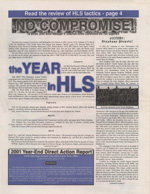

-
Periodicals
Lomakatsi
09.07.12 | PermalinkLomakatsi #1, 2, 3, and 4 (1987-1989, Washington, DC)
Many of the participants in the first boom of U.S. animal liberation activity were radicals, and not just when it came to their critique of non-human slavery. As I have mentioned in previous posts, speciesism is so intrinsic to most cultures that people embracing a pro-animal ethic almost always came from the fringes. These early pioneers pushed the message, took direct action, and put the plight of animals front and center in works of art, music, and literature. What became of these rebels when the movement became more mainstream, and thus more profitable to the careerists at national organizations? As a generation of gray, corporate pseudo-activists began to wield suits and ties instead of spanners and bolt cutters the old guard revolted in a variety of ways- one of which was an eclectic, anarchist journal known as Lomakatsi.
Taking the Hopi word for “Life in Balance,” a small collective of artists and activists set out to reject the dominant themes running through other, tamer publications. More than that, they started a project to live communally on a small parcel of land and experiment with more sustainable, less technological ways of living. By sharing their space with each other, and their thoughts with the world, the rebels continued to have an impact on the direction of the mvoement.
During it’s short life, Lomakatsi circulated about 1,000 copies per issue, introduced anti-civilization themes to AR folks through articles by John Zerzan, (And a letter from Feral Faun in one issue!) and stirred up plenty of controversy. Each issue contained DIY instructions for sabotage, oddball illustrations and comics, and advocacy for some ideas that were challenging to say the least. Their intentional community eventually stopped producing a journal, but those following animal liberation history will certainly see the influence that Lomakatsi had on our movement’s dialogue as we moved into the 1990s.
-
No Compromise, Periodicals
No Compromise #15-17
09.01.12 | PermalinkNo Compromise #15,16, 17 (2000-2001, Santa Cruz, CA.)
I want to preface this post with this: The turn of the century was an epic time to be alive and fighting! Between the WTO riots, a huge upsurge in ALF attacks on the West Coast, some inspiring support of grand jury resisters, and the migration of the SHAC campaign to the United States, there were also thousands upon thousands of other actions across the planet. It was hard to keep up with all of the news because it seemed that people everywhere had finally taken enough and were beginning a counter strike for non-humans, wilderness, and human freedom. Luckily, No Compromise kept track of most of the action, and produced three excellent issues during this incredible year of revolt. Beyond the coverage of the latest direct actions, attention was also paid to our past successes and failures- and all animal activists would do well to read issue #16’s “Blast From The Past” article about lab raids in the 1980s.
-
One-off publications
North American Earth Liberation Front Press Office Subcommittee on Eco-Terrorism
05.22.12 | PermalinkNorth American Earth Liberation Front Press Office Subcommittee on Eco-Terrorism (2002, Portland, OR)
One of the most frequently repeated myths about direct action is that is so damaging to public opinion that if people didn’t already do it, the government would in order to criminalize movements. If this were true it certainly seems that the system would spend less time trying to prevent radical action by silencing it’s proponents and more time harassing the Sierra Club. The truth is that nothing scares corporations and their paid-in-full politician pets like a well organized group with a willingness to fight and the ability to reach the public with their ideas.
In the late 1990s environmental sabotage was happening all across the world, but was particularly frequent in the northwest of the United States. At the forefront of these actions was the Earth Liberation Front, an anonymous, underground group, who utilized above ground spokespeople to reach the public. Their primary conduit for media relations was an activist from Portland named Craig Rosebraugh and his organization, the North American ELF Press Office. For his role in publicizing the motivations and rhetoric of the ELF he had his arm broken by the police, his home raided by Joint Terrorism Task Forces, his break cables cut, was repeatedly subpoenaed to grand juries, and eventually was called to testify before a congressional sub-committee who hoped to imprison him on contempt charges. The so-called “Eco-Terror committee” surely hoped that Craig would be an easy target, but that didn’t exactly work out for them. Snarky, educated, and angry, Craig’s testimony ran the gamut from stonewalling, to educational, to hilarious. For example, while running the Press Office with his friend Leslie James Pickering, Craig owned a bakery. When asked how the press office was funded, Rosebraugh simply replied “muffins.” When asked who had asked him to become the ELF press officer and how he was contacted, Craig responded, “Jesus Christ. It was a spiritual sort of thing.”
Jokes aside, a congressional subpoena represented a shift in the way environmental sabotage was being treated by the system, and publicizing that fact fell to Leslie James Pickering. In order to spread the word about the hearings, the NAELFPO sold a DIY booklet containing all of the testimony presented by both sides at the hearing and the subsequent written questions sent to Craig by the subcommittee. In a recent conversation with Conflict Gypsy about the booklet, Pickering had this to say:
“I can’t say for sure, how many of these were printed, but it was definitely less than 500. I had a little production line going, with people wearing gloves and hats, only half-jokingly, recently having learned about the WUO and Prairie Fire. The subcommittee was in February of 2002 and I left Portland in June of 2002. These booklets were produced somewhere in between there…probably March or April, because I utilized some machinery they had at college before the semester let out and because this was actually in peoples’ hands before it was easily found online. They were distributed through the ELF Press Office, which means that people could send us $10 and get a copy mailed, or get one at one of our event tables. A good chunk of them also went to AK distro, but we never saw a cent from those, which is another story. One of the more interesting aspects were the complaints from anonymous anarchists about it costing too much. This was when the PO was being bombarded with anonymous comments which were critical from many angles. I often think of how much work went into this and how cheap these people were, assuming for a moment that they weren’t all feds. If we didn’t have the old magnet scam going [where large magnets would be used to reset the copy keys at Kinkos – ed] we would probably have lost money at $10, because it was a pretty thick booklet.”

-
Periodicals
Frontline #3-4
10.02.11 | PermalinkFrontine #3-4 (1986-1987, Toronto, Canada.)
Conflict Gypsy’s Canadian section grows substantially with these two issues of Frontline. Predating Combat and Underground, Frontline offers a peak into the development of the Canadian Animal Liberation Front Support Group and also into the early histories and first hand accounts of the Canadian ALF.
The difference between #3 and #4 illustrate the growth and spread of the Canadian ALFSG; #4 more than doubles the size of #3 and you see a definite interest in design as the publication grows.
For someone who currently organizes in this exact same area, this post is bittersweet. Activists left from this era are extremely rare and very few know this history (although it is important to note that ARK-II is still active!).
We are dedicated to searching out and preserving this history in order to help bridge that gap. If you can help us find other issues of Frontline, Combat or any other Canadian publication of interest, please contact us at conflictgypsy (at) gmail (dot) com
…

-
Periodicals
Out of the Cages #6-9
05.19.11 | PermalinkOut of the Cages #6 – 9 (1993-1994. Santa Cruz, CA. USA)
Out of the Cages is a wonderful magazine that filled an important niche in the pre-internet, pre-No Compromise 90s. As the main west coast publication of its time, it had a link to the 80s glory days that ran deep in the area it was printed. Santa Cruz had been the home of early US hunt saboteurs and the earliest cooperation between animal rights activists and Earth First! took place there. Rod Coronado, Jonathan Paul, and other early AR radicals called it home. This proximity to history gave the magazine a much different tone than Holocaust, or Dressed in Black, and unlike Militant Vegan, the group publishing OOTC were above ground liberationists, accessible for correspondence and submissions. This meant that the zine was always filled with fresh perspectives, letters, and debate, and that eventually groups from across the country got in touch to share ideas and announce their campaigns.
Conflict Gypsy would very much like a complete set of Out of the Cages. If you have any please contact us at conflictgypsy {{at}} gmail ((dot)) com
…

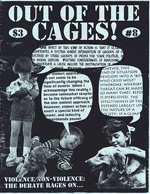

-
Periodicals, Underground
Underground #1-3
03.14.11 | PermalinkUnderground # 1-3 (1994-1995. Vancouver, British Columbia, Canada.)
Underground was published by the North American Animal Liberation Front Supporters Group and was essentially a continuation of the old Canada ALFSG publication, Combat. Because the NAALFSG went through constant staff changes, police raids, and office burglaries, the magazine often went long stretches between installments, but the first year managed to produce three long, enjoyable issues .
The early editions of this magazine were the most essential, as the quality lagged by the end of its run. Articles with practical advice on everything from handling grand jury subpoenas to sabotaging steel jaw leg hold traps appeared during this era, and the tone of the magazine was measured and reasonable. Commentary on how targeting of actions should account for political repercussions and avoid unintended racist and classist undertones showed a maturity seldom seen in other movement papers at the time.
Of historical importance is the coverage of grand juries in the 90s, early attempts at organizing AR activists on the internet, the frequent and ignored violence against animals activists, and the death of Jill Phipps during the campaign against live exports. Young activists would do well to read these issues, as the time period covered spans the gap between the end of Out of the Cages, Militant Vegan, Dressed in Black, and the start of No Compromise.
On a final, sad note, much of the best content for Underground was written by, or about, Canadian activist Darren Thurston. Darren was an inspiration to the movement, and participated in a number of high profile actions that earned him jail time and constant surveillance. After years of fighting bravely for animal liberation, Darren unexpectedly became a government informant and stopped being vegan during his last sentence in federal prison. The staff of Conflict Gypsy would like to assert that publication of his old articles is for archival purposes and should not be seen as forgiveness or support for his treacherous actions.
Also see Underground 4-6, Underground 7-9, Underground 10-13, Underground 14-15, Underground 16 and the final rare issue Underground 17.
…


